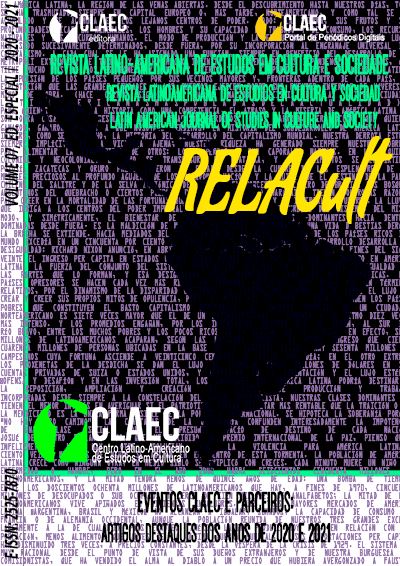Marching “Artivism” and Performances
Anthropological analysis of the SlutWalk in Recife, 2019
DOI:
https://doi.org/10.23899/relacult.v7i4.2193Keywords:
Corporartura, Slutwalk, Performance, ArtivismAbstract
This article consists of an analysis of the 9th edition of the 2019 Slutwalk in Recife from the field experience and the theoretical enterprise of performance anthropology. I frame the march as an artivist performance, combining an aesthetics of confrontation with an ethics of resistance, marked by a “communication without anesthesia”. With this, a new analytical category is proposed in the study of artivist performances, which I called corporartura, which represents artistic writing by bodies.
References
BARROS, L. M. Comunicação sem anestesia. Intercom, Rev. Bras. Ciênc. Comun., São Paulo , v. 40, n. 1, p. 159-175, Apr. 2017 .
BAUMAN, Richard. Fundamentos da performance. Revista Sociedade e Estado, vol 29. n 3 Setembro/Dezembro, pp. 727-746. 2014.
BAUMAN, R. Verbal art as performance. American Anthropologist, n. 77, 1975, p. 290-311.
BUTLER, J. Quadros de guerra: Quando a vida é passível de luto?. Civilização Brasileira, Rio deJaneiro, 2016.
CARERI, Francesco. Walkscapes: o caminhar como prática estética. Trad: Frederico Bonaldo. 1. ed. São Paulo : Editora G. Gili, 2013.
COSTA, C. L.; ALVAREZ, S. Translocalidades: por uma política feminista da tradução. Revista Estudos Feministas, Florianópolis: UFSC, vol.17, no3, p. 739-742, 2009.
CSORDAS, Thomas J. A Corporeidade como um Paradigma para a Antropologia, In: Corpo/Significado/Cura, Porto Alegre : ed. UFRGS, (1990) , pp. 101-146. 2008.
FABIÃO, E. (2008). Performance e teatro: poéticas e políticas da cena contemporânea. Sala Preta, 8, 235-246.
GARRABÉ, L. O Estudo das Práticas Performativas na Perspectiva de uma Antropologia da Estética. Revista Brasileira de Estudos da Presença, Porto Alegre, RS, v. 2, n. 1, p. 54-77, jun. 2012.
GOLDFARB, R. C.; MINELLA, L. S.; LAGO, M. C. S. Marcha das Vadias na Paraíba: sororidades, performances e linguagens. Seminário Internacional Fazendo Gênero 10 (Anais Eletrônicos), Florianópolis, 2013.
LANGDON, E. J. Performance e sua Diversidade como Paradigma Analítico: A Contribuição da Abordagem de Bauman e Briggs. Revista de Antropologia, Florianópolis, UFSC, pp. 163-183, 2007.
MARTINS, L. M. Performance da oralitura: corpo, lugar da memória. Revista Letras, programa de pós-graduação em Literatura da UFSM, n. 26, PP. 63-81. 2003.
MOURÃO, Rui. “Performances artivistas: incorporação duma estética de dissensão numa ética de resistência”, Cadernos de Arte e Antropologia [Online], Vol. 4, No 2 | out. de 2015.
SANTOS, E. F. Corpo Livre: Corpo E Arte Como Formas De Ativismo Em São Paulo. GIS - Gesto, Imagem E Som - Revista De Antropologia 4 (1). São Paulo, Brasil:125-56. 2019.
SCHECHNER, R., 2003. “O que é Performance?” in: O Percevejo - Revista de Teatro, Crítica e Estética. Estudos da Performance, UNIRIO, ano 11, nº12, pp. 25-50.
TAVARES, A. O. A. “Tô de minissaia, não te devo nada”: vestimenta como elemento político na Marcha das Vadias Recife - PE. Dissertação (Mestrado em Antropologia). Universidade Federal de Pernambuco. Recife. 2020.
TAYLOR, D. 2013. “Traduzindo Performance [prefácio]”. In: Dawsey, J. C et al. (orgs.) Antropologia e Performance. Ensaios NAPEDRA. São Paulo: Terceiro Nome, pp. 9-16.
RAGO, M. Adeus ao Feminismo? Feminismo e (Pós) Modernidade no Brasil. In: Cadernos AEL. Campinas: Arquivo Edgard Leuenroth, Instituto de Filosofia e Ciências Humanas, Unicamp 1995/1996, n. 3/4, p. 11-43.
RAPOSO, P. A ‘revolta das barcas’: sobre silenciamento performático e imaterialidade do protesto na (in)visibilidade contemporânea das periferias urbanas. Revista do GIS, São Paulo, v. 1, n. 1, p. 59 - 88, junho (2016).
Downloads
Published
Issue
Section
License
Copyright (c) 2021 Maria Fernanda Valeriano Benevides Viana

This work is licensed under a Creative Commons Attribution-NonCommercial 4.0 International License.
Authors who publish in this journal agree to the following terms:
Authors retain the copyright of their works and grant RELACult the right of first publication. All articles are simultaneously licensed under the Creative Commons Attribution 4.0 International (CC BY 4.0), which allows sharing, distribution, copying, adaptation, and commercial use, provided that proper credit is given to the original authorship and the first publication in this journal is acknowledged.
RELACult makes all of its content openly accessible, thereby increasing the visibility and impact of the published works. The contact information provided in the submission system is used exclusively for editorial communication and will not be shared for any other purpose.

